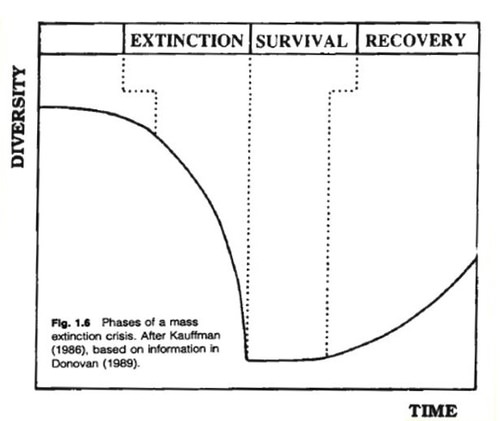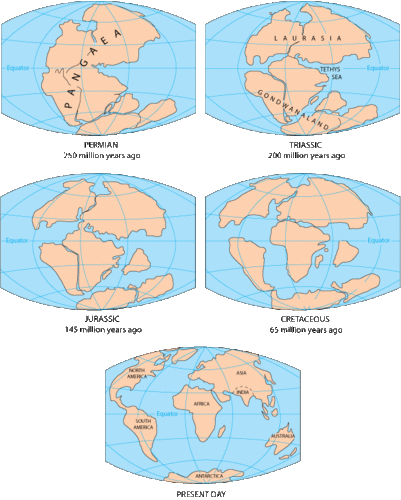8.2 五大大规模灭绝
章节大纲
-
Mass Extinctions
::大规模灭绝Though organisms change and evolve, the most dramatic changes occur during mass extinction events, defined as a period of time when the rate of species going extinct is increasing with respect to the rate at which new species arise. Throughout the Phanerozoic era, there were 15 documented major extinction events. Five of these were major mass extinction events where more than half of all species on Earth at the time were lost.
::尽管生物在变化和演变,但最剧烈的变化发生在大规模灭绝事件期间,被界定为物种灭绝速度随着新物种的出现速度而上升的时期,在整个Phanerozoic时代,有15起有记载的重大灭绝事件,其中5起是重大大规模灭绝事件,当时地球上所有物种中有一半以上已经消失。Mass extinctions can be either gradual or sudden. The process of extinction follows five different phases:
::大规模灭绝可以是逐步的,也可以是突然的。-
First is the extinction phase, which features a rapid decrease in biotic diversity.
::第一是灭绝阶段,其特点是生物多样性迅速减少。 -
The second phase is the survival phase. Diversity is at a minimum here, but there is little further extinction. Organisms that survive past the second phase are known as the holdover taxa.
::第二个阶段是生存阶段。 多样性至少在这里存在,但几乎没有进一步的灭绝。 在第二个阶段之后存活下来的有机体被称为缓存类。 -
Third is the rebound phase. Diversity begins to slowly increase again as ecosystems recover from the extinction event. The term progenitor taxa is used to describe species that have survived and now
provide
the evolutionary seeds for future organisms.
::第三是反弹阶段。 随着生态系统从灭绝事件恢复过来,多样性开始慢慢地再次增加。 后代群一词用来描述生存下来的物种,现在为未来生物提供了进化种子。 -
The fourth phase, the expansion phase, is marked by a rapid increase in diversity due to the evolution of new species. The increase in diversity is helped in part by the opportunities and voids left by the many species lost during the first phase.
::第四阶段,即扩展阶段,由于新物种的演变,多样性迅速增加,在第一阶段丧失的许多物种所留下的机会和空白部分有助于多样性的增加。 -
The last phase, a recovery interval, is marked by a long period of environmental stability as diversity continues to rise. Disaster taxa describe species that proliferate most successfully following an extinction event. They are typically small and simple, hardy rather than complex and therefore capable of surviving extinction events.
::最后一个阶段,即恢复间隔期,随着多样性的继续增加,环境稳定期很长。 灾害分类描述在灭绝事件发生后最成功的物种扩散。 它们通常规模小、简单、硬,而不是复杂,因此能够幸存下来的灭绝事件。
The phases of a mass extinction. Diversity is given on the y-axis with time on the x-axis. Consider a mass extinction event with multiple pulses of extinction. What would you expect the graph of diversity vs. time to look like in that case?
::大规模灭绝的阶段。 多样性在 Y 轴上给出, 时间在 x 轴上。 考虑大规模灭绝事件, 多脉冲的灭绝。 您期待多样性图和时间图在这样的情况下看起来像什么 ?Evidence for extinction events come from sweeping changes in the fossil records at different geological changes. However, fossils provide an incomplete and often confused record of past life. Roughly one third of organisms feature calcified parts that could be turned into fossils. The erosion of sedimentary rock may also obscure how old a fossil really is. Our understanding of mass extinctions is therefore inversely proportional to their age (older events have less certain evidence), and is proportional to the extent of the extinction. Extinction events that caused a greater loss in diversity are easier to categorize.
::有关灭绝事件的证据来自不同地质变化的化石记录的巨大变化,但是,化石提供了过去生活的不完整和往往混乱的记录。大约三分之一的生物特征是可变成化石的刻板部件。沉积岩的侵蚀也可能掩盖化石的老化程度。因此,我们对大规模灭绝的理解与其年龄成反比(老事件没有确切的证据),与灭绝的程度成正比。造成多样性更大程度损失的清除事件比较容易分类。While mass extinction events threaten the very presence of life on Earth, they also lead to enhanced evolutionary diversity. It is important to understand these ubiquitous pressures on life, as similar events are likely to occur on every planet. If life is easily and regularly eliminated through frequent extinction events, then it may make finding surviving life in the Universe much harder.
::尽管大规模灭绝事件威胁到地球上生命的存在本身,但它们也导致进化多样性的增强。 重要的是要理解这些对生命无处不在的压力,因为每个星球都可能发生类似的事件。 如果生命通过频繁的灭绝事件很容易和经常地被消灭,那么在宇宙中寻找生存生命可能就更加困难了。The Ordovician-Silurian (O-S) Extinction
::奥多维奇人-西里留里安人(O-S)The Ordovician-Silurian (O-S) extinction, which occurred 450-440 Mya, describes two events that together resulted in the loss of nearly 70% of the worlds species at the time, making this the second-largest mass extinction event. The extinction event had a global effect and particularly affected marine life, where it is estimated that nearly 85% of species were lost.
::Ordovician-Silurian(O-S)灭绝了450-440 Mya(O-S),它描述了两个事件,这两个事件一起导致当时世界物种的近70%的丧失,使之成为第二大大规模灭绝事件。 灭绝事件产生了全球影响,特别是影响了海洋生物,据估计,在海洋生物中,近85%的物种丧失了。The event was most likely caused through sudden climate changes. The timeline matches up with a shift in the then super-continent, Gondwana, into the south pole. As Gondwana passed over the south pole, it began to form ice caps across its surface. T his shift also exposed more land, causing a drop in C O 2 levels through weathering and cooling the planet .The cooling of the Earth led to the formation of glaciers, which locked up waters from the ocean. This, in turn, caused sea levels to drop, exposing and destroying shallow-water habitats along continental shelves. Evidence for glaciation during this time period has been found in the Sahara Desert. The combination of glaciation and cooling is thought to be the main causes of the O-S extinction.
::该事件最有可能是由突发的气候变化引起的。 时间轴与当时的超级大陆Gondwana向南极的转变相吻合。 当Gondwana经过南极时, 它开始形成横跨其表面的冰盖。 这一转变还暴露了更多的土地, 通过气候变暖和冷却造成二氧化碳水平的下降。 地球的冷却导致了冰川的形成, 这些冰川将海洋的水域封闭起来。 这反过来又导致海平面沿大陆架的浅水生境下降、暴露和破坏。 在此期间,撒哈拉沙漠发现了冰川沉积的证据。 冰川和冷却的结合被认为是O- S灭绝的主要原因。The event ended when volcanic out-gassing of greenhouse gases increased the atmospheric temperatures enough to melt the glaciers and stabilize sea levels. The rebound phase of the O-S extinction resulted in increased biodiversity on the re-flooded continental shelves. However, recovery species in the ocean and land plants of the time were initially less complex.
::火山排放温室气体使大气温度升高,足以融化冰川和稳定海平面,导致火山-S灭绝的反弹阶段导致重新受污染的大陆架生物多样性增加,但当时海洋和陆地植物的恢复物种最初不太复杂。The Late Devonian Extinction
::已故德文灭绝At least 70% of all species were also lost during the Late Devonian extinction, which lasted from 375-360 Mya. There is some evidence that this extinction event was actually a series of seven,distinct extinction pulses. As with the O-S extinction, marine life was particularly hard hit.
::所有物种中至少有70%在后德文灭绝期间也丧失了生命,该灭绝持续了375-360 Mya。有证据表明,这一灭绝事件实际上是一系列七颗截然不同的灭绝脉冲。 与O-S灭绝一样,海洋生物受到的打击尤其严重。The Late Devonian extinction is thought to have been caused by changes in the sea level, triggered by global cooling combined with acidification and oxygen depletion in the oceans similar to the O-S extinction, changing sea levels, or oceanic volcanism.
::据认为,后德文的灭绝是由海平面的变化引起的,这种变化是由全球冷却以及海洋酸化和氧耗竭引起的,类似于O-S灭绝、海平面变化或海洋火山。The rapid evolution of more complex plants from 30 cm up to 30 m during this period likely contributed to the oxygen depletion in the ocean. The increase in plant mass required the development of extended root and vascular systems in plants. These roots would have stabilized increasingly deeper layers of soil, causing a change in the chemical composition of which nutrients were run off into rivers, lakes, and eventually the ocean. This effect could have decreased the amount of oxygen in the oceans as well as reduced CO 2 levels, which would have contributed to global cooling.
::较复杂的植物在这一时期从30厘米到30米的迅速演变,很可能导致海洋氧气耗竭,植物质量的增加需要植物中长根和血管系统的发展,这些根本可以稳定日益深的土壤层,导致化学成分的变化,养分流入河流、湖泊,并最终流入海洋,这种影响本可以减少海洋中的氧气量,减少二氧化碳水平,从而导致全球冷却。Less oxygen in oceans also caused organic matter to be better preserved, preventing organisms from decomposing and recycling their nutrients. Instead, many organisms formed into oil, which was absorbed by the porous reef rocks common in the area. These oil deposits remain a major source of oil in America today.
::海洋氧气减少还导致有机物得到更好的保存,防止有机体分解和回收养分。 相反,许多有机体形成石油,被该地区常见的多孔礁岩吸收。 这些石油储量仍然是当今美国的主要石油来源。The End Permian Extinction
::结束的百年灭绝The End Permian extinction (or Permian-Triassic or P-T extinction) occurred about 252 mya and is the single largest mass extinction event ever recorded. It is nicknamed the "The Great Dying." Approximately 96% of all marine life was lost along with over 70% of land species, including everyone's favorite prehistoric creature, the trilobite.
::最终的珀尔米亚灭绝(或Permian-Triassic 或 P-T 灭绝)大约发生252 兆米,是有史以来最大的一次大规模灭绝事件。它被命名为“大死亡 ” 。 大约96%的海洋生物和70%以上的陆地物种,包括每个人最喜爱的史前生物,即三叶石。
Trilobite fossils available for sale.
::三边化石可以出售The cause of such a large extinction was most likely the final stages of the break up of Pangea. The shifting of continents caused molten rock to be exposed and increased volcanic activity, releasing volatile carbon, methane, and SO 2 . The effect is actually quite similar to that of burning fossil fuels today. The Earth began to heat up under this new blanket of greenhouse gasses; it is thought that the temperature of the entire ocean increased by 2 °C .
::造成如此大规模灭绝的原因很可能是潘热亚解体的最后阶段。 大陆的变化导致熔岩暴露,火山活动增加,释放了挥发性碳、甲烷和硫磺2 。 其效应实际上与今天燃烧化石燃料的效果相当相似。 地球开始在新的温室气体层之下发热;人们认为整个海洋的温度上升了2°C。The supercontinent Pangaea began to break up about 200 million years ago, eventually fragmenting into the continents that we see today.
::超级大陆潘加亚在大约两亿年前开始分裂,最终分裂到我们今天所看到的大陆。Warm ocean water transported heat to the poles, which in turn began to melt and release more greenhouse gases that had been frozen before. As the amount of CO 2 increased in the atmosphere, it likewise began to dissolve and accumulate in the oceans, causing oceans to acidify. Furthermore, the warmer ocean water was unable to hold as much oxygen. The combination of increasing acidity and decreasing oxygen likely gave rise to the grievous destruction of marine life during the P-T extinction.
::温暖的海水将热量输送到两极,而两极又开始熔化和释放更多的以前被冷冻的温室气体。随着大气中二氧化碳含量的增加,二氧化碳也开始溶解和在海洋中积累,导致海洋酸化。此外,较温暖的海水无法保持同样多的氧气。酸性增加和氧气减少加在一起,可能导致P-T灭绝期间海洋生物受到严重破坏。The End Triassic Extinction
::结束三三assic 灭绝The End Triassic extinction occurred 200 Mya, with 70-75% of all species becoming extinct. Most of the large amphibians common at the time were eliminated, and d inosaurs were left with little competition, allowing them to flourish in the following Jurassic period.
::最终的三亚西克灭绝发生在200个 Mya, 全部物种中有70-75%已经灭绝。 当时常见的大型两栖动物大多被消灭,恐龙几乎没有竞争,让它们在随后的侏罗纪时期蓬勃发展。The end Triassic extinction event was sudden, lasting less than 10,000 years. Many causes have been proposed, but none are definitive. Gradual climate change can explain some of the observed properties of the extinction. An asteroid impact could also explain some of the properties of the extinction, but a crater of the appropriate size and age has yet to be found. The extinction may also have been caused by an unlucky sequence of volcanic eruptions increasing the release of carbon dioxide and sulfur and triggering climate change. Increased amounts of volcanic compounds can be found in the rock layers from this period.
::Triassic灭绝事件的结束是突然的,持续时间不到一万年。许多原因已经提出,但没有确定。 渐变的气候变化可以解释所观察到的灭绝的一些特性。 小行星撞击也可以解释灭绝的一些特性, 但还没有找到一个大小和年龄适当的弹坑。 灭绝也可能是由于不幸运的火山爆发序列增加二氧化碳和硫磺的释放并引发气候变化造成的。 从这一时期开始,在岩石层中可以发现火山化合物的增加。The Cretaceous-Paleogene (K-T) Extinction
::白鲸-白鲸(K-T)灭绝The Cretaceous-Paleogene (K-T) extinction occurred 66 Mya, and 75% of species became extinct, including all land-bound dinosaurs. Dinosaur fossils are only ever present before this time in the rock records. The extinction had a surprisingly variable impact, with dinosaurs being greatly affected while mammals and birds survived to ultimately become the predominate life forms on the planet.
::白龙-白龙(K-T)灭绝发生于66个 Mya, 75%的物种灭绝,包括所有陆界恐龙。 在此之前,恐龙化石才出现在岩石记录中。 灭绝产生了令人惊讶的多变影响,恐龙受到极大影响,哺乳动物和鸟类最终成为地球上最主要的生命形式。The rock record from this time exhibits an unusual amount of iridium with gold, osmium, and platinum. These elements are relatively rare on Earth, but are commonly found in meteorites. The amounts of these rare metals could have been contained in an asteroid that was 10-15 km in diameter. The energy from such an asteroid would be equivalent to the force of 100 million hydrogen bombs. Other evidence includes shocked quartz and spherical rock droplets, which require both high temperatures and great pressure to form. Widespread soot deposits also suggest enormous fires across land masses.
::这一时期的岩石记录显示,金、和白金的含量异常之大。这些元素在地球上相对罕见,但通常在陨石中发现。这些稀有金属的数量可能包含在直径为10-15公里的小行星上。这种小行星的能量相当于1亿枚氢弹的威力。其他证据包括震撼的石英和球状岩滴子,它们需要高温和高压形成。广泛的烟尘沉积也表明陆地大面积大火。The Chicxulub crater, buried beneath the Yucat á n Peninsula in Mexico has both the appropriate age and size that are expected of the asteroid that could have caused the devastation seen during the P-T extinction event. The crater stretches 150 km across and is approximately 20 km deep.
::埋在墨西哥尤卡坦半岛下的Chicxulub弹坑,其年龄和大小都与小行星预期的相同,该小行星可能造成P-T灭绝事件期间所看到的破坏,该弹坑横跨150公里,深约20公里。
A map showing the extent of the Chicxulub crater. It is now buried under the Yucatán peninsula in Mexico. What dimensions of the crater provide an indication of the mass of the asteroid that must have caused it? E.g. how would the impact crater for a larger asteroid or a smaller asteroid differ?
::显示 Chicxulub 弹坑范围的地图。 该弹坑现在被埋在墨西哥的尤卡坦半岛之下。 弹坑的哪个维度能显示该小行星必须造成的质量? 例如, 大小行星或小小行星的撞击坑会如何不同?Extinctions and Life
::灭绝和生命While mass extinctions are devastating, they do serve to encourage diversity. Had the dinosaurs not been eliminated 65 Mya, there may never have been such a successful emergence of mammals. The frequency of life in the Universe is a function of how often it arises, how often it survives, and how long it endures after evolving. In this way, the frequency and intensity of mass extinctions control the frequency of life. On Earth, there have been 15 major mass extinctions in the last 500 million years. Five of those 15 eliminated more than half of all species on the planet.
::虽然大规模灭绝是毁灭性的,但它们确实有助于鼓励多样性。 如果恐龙没有被消灭65 Mya, 哺乳动物的出现可能从未如此成功。 宇宙中生命的频度取决于它的出现频率、生存频率和演变后的存续时间。 这样,大规模灭绝的频率和强度就能控制生命的频度。 在地球上,过去5亿年中发生了15次大规模灭绝。 其中5次消灭了地球上一半以上的物种。 -
First is the extinction phase, which features a rapid decrease in biotic diversity.

